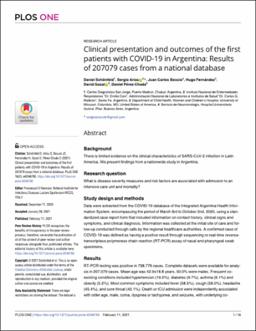| dc.description.abstract | Abstract
Background: There is limited evidence on the clinical characteristics of SARS-CoV-2 infection in Latin America. We present findings from a nationwide study in Argentina.
Research question: What is disease severity measures and risk factors are associated with admission to an intensive care unit and mortality?
Study design and methods: Data were extracted from the COVID-19 database of the Integrated Argentina Health Information System, encompassing the period of March 3rd to October 2nd, 2020, using a standardized case report form that included information on contact history, clinical signs and symptoms, and clinical diagnosis. Information was collected at the initial site of care and follow-up conducted through calls by the regional healthcare authorities. A confirmed case of COVID-19 was defined as having a positive result through sequencing or real-time reverse-transcriptase polymerase chain reaction (RT-PCR) assay of nasal and pharyngeal swab specimens.
Results: RT-PCR testing was positive in 738,776 cases. Complete datasets were available for analysis in 207,079 cases. Mean age was 42.9±18.8 years, 50.0% were males. Frequent co-existing conditions included hypertension (19.2%), diabetes (9.7%), asthma (6.1%) and obesity (5.2%). Most common symptoms included fever (58.5%), cough (58.0%), headache (45.4%), and sore throat (42.1%). Death or ICU admission were independently associated with older age, male, coma, dyspnea or tachypnea, and seizures, with underlying co-morbidities such as immunodeficiency, chronic renal failure, and liver disease showing the strongest effects.
Interpretation: Most cases of COVID-19 diagnosed in Argentina were mild and had a favorable outcome, but fatality rates were relatively elevated. Risk factors for adverse outcome included older age, male sex, coma and seizures, and the concurrent presence of several morbidities. These data may be useful for healthcare providers and healthcare policy makers of low-middle income and Latin American countries to guide decisions toward optimized care during the pandemic. | es |


